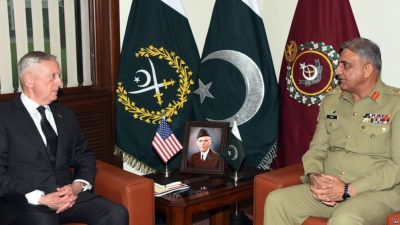US Cuts off Aid to Pakistan, Obstructing Pakistan’s Economic Cooperation with China

Note to readers: please click the share buttons above
The US military suspended $300 million in aid to Pakistan.
Technically speaking, the US didn’t cut off actual “military aid” in the physical sense that it’s widely perceived to have done but blocked money that “was part of reimbursement for the loss of lives and financial losses that Pakistan suffered while leading the fight against terrorism”, according to a clarification by Pakistan’s new Foreign Minister. In any case, this hostile move is being done in order to advance several interconnected American objectives, the most public being to scapegoat Pakistan for the US’ failures in Afghanistan while the highest-level strategic one is to continue the US’ policy recalibration towards India as its preferred partner in South Asia.
The supposed pretext of Pakistan not doing enough to crack down on terrorist groups is disingenuous because the country doesn’t harbor such forces and has actually been victimized by them over the decades to the tune of over 60,000 martyrs. Nevertheless, the US attempts to weave a semi-“believable” narrative in this regard by pointing to the active cross-border Pashtun community on both sides of the Durand Line, implying that Taliban members simply cross over into Pakistan from Afghanistan in order to seek reprieve from American airstrikes. That’s also not necessarily the case either, and the situation is more complex than such a simplistic storyline would suggest.
No armed militants enter Pakistan through official border crossings, which are among the most secure in the world, though Islamabad can’t realistically screen each and every unarmed person arriving from Afghanistan for Taliban sympathies. As for those that might try to sneak into the country illegally, they’ve found that to be pretty difficult in recent years and it’ll eventually become impossible once the border fence with Afghanistan is completed. Therefore, the whole case that the US is trying to make about Pakistan supposedly “harboring terrorist groups” and “actively aiding” them is false from the get-go and designed to damage the country’s international reputation.
It’s not just for the sake of trying to harm Pakistan’s standing in the world and “virtue signaling” to its new Indian strategic partner that Washington is nastily disengaging from its erstwhile close relationship with Islamabad, but also because it may be preparing the narrative ground for sanctioning its former South Asian ally on supposed “terrorist” grounds that really have everything to do with obstructing CPEC. The US is building the perception that Pakistan is a “terrorist-infested” country in order to “legitimize” what might be a forthcoming comprehensive sanctions campaign against it similar to the one that it’s currently waging against Iran and which it recently began against Turkey.
Expanding the US’ existing economic warfare battlefield in the region to Pakistan would encompass the South Eurasian Rimland portion of the so-called “Greater Middle East” that forms the southern half of the Golden Ring of multipolar Great Powers, which would put severe pressure on this very promising 21st-century geopolitical construction, particularly as it relates to the possibility of imposing “secondary sanctions” against companies that use the Pakistani-transiting CPEC. The whole point is to decrease the economic appeal of this game-changing Silk Road corridor as part of the US’ “containment” strategy against Pakistan and China, though it might unintentionally catalyze the same transregional integrational processes that it’s trying to sabotage.
*
This article was originally published on Oriental Review.
Andrew Korybko is an American Moscow-based political analyst specializing in the relationship between the US strategy in Afro-Eurasia, China’s One Belt One Road global vision of New Silk Road connectivity, and Hybrid Warfare. He is a frequent contributor to Global Research.
Featured image is from the author.

